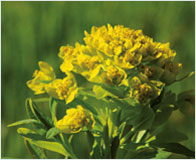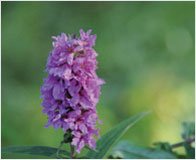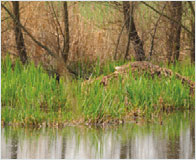- ι
- ι
- ι
- ι
- ι
- ι
- Visitor Information
- ι
Wetland Ponds - Ups and DownsSlide show
Now you see it...The view across Baumberger Hamm changes with the seasons. Depending on when you come here, you will see a sheet of water, only mud, or burgeoning plants. Seven hundred years ago, the River Rhine had its bed in this hollow. All that remains now is a marshy pond whose water level depends on rainfall, ground water, and flooding. In summers with little rain the pond will dry up completely.

marsh spurge

purple loosestrife

home of a muskrat
Living with change
Plants and animals have adapted to the changing water levels. When the water recedes, marsh plants like water dropwort (also known as water fennel) and great yellowcress colonize the muddy ground. By this time, amphibious animals such as water frogs and crested newts have completed their evolution from eggs to aquatic larvae to adult animals. If the pond dries up, they migrate to damp reed beds or ditches.
All the year round
In early spring you may still see little grebes on the water, but in April, at the start of the breeding season, they disappear into the dense vegetation on the pond's edge. Listen for the long trills that indicate their whereabouts. In May the rare marsh spurge and yellow iris open bright blossoms and the frogs begin to perform their choruses. From July to September, purple loosestrife lends colour to the landscape. In autumn and winter the conical reed "lodges" that the muskrat build are easy to spot.
Plants and animals have adapted to the changing water levels. When the water recedes, marsh plants like water dropwort (also known as water fennel) and great yellowcress colonize the muddy ground. By this time, amphibious animals such as water frogs and crested newts have completed their evolution from eggs to aquatic larvae to adult animals. If the pond dries up, they migrate to damp reed beds or ditches.
All the year round
In early spring you may still see little grebes on the water, but in April, at the start of the breeding season, they disappear into the dense vegetation on the pond's edge. Listen for the long trills that indicate their whereabouts. In May the rare marsh spurge and yellow iris open bright blossoms and the frogs begin to perform their choruses. From July to September, purple loosestrife lends colour to the landscape. In autumn and winter the conical reed "lodges" that the muskrat build are easy to spot.
Search:






